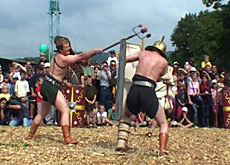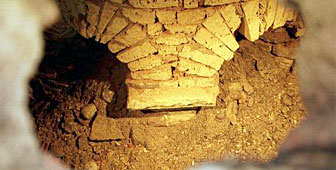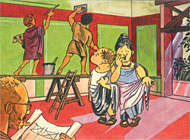Roman titans clash near Basel

Gladiators have been proving that they can still pull the crowds in Switzerland, 2000 years after their heyday.
Thousands turned out to watch bare-foot fighters dressed in traditional gladiator gear battle it out at the weekend’s Roman Festival in the ancient settlement of Augusta Raurica near Basel.
A colourful procession kicked off the first contest on Sunday. A battalion of legionnaires in armour, followed by dancers and musicians in robes and togas, trod a path down to the makeshift arena, where fighters pitched their wits and strength against each other.
In one contest, a gladiator used a trident and net – a particularly difficult combination – to overcome his opponent, drawing gasps of admiration and applause from the rows of spectators.
In Sunday’s contest, the gladiators were led by their trainer, experimental archaeologist, Markus Junkelmann.
Junkelmann travels around Europe staging gladiatorial contests with a willing band of fighters from Germany, kitted out in weapons and armour, much like those used by gladiators in ancient Rome.
“We are demonstrating the fighting techniques with wooden swords, as the Romans did in the first fights before sharp weapons were used,” Junkelmann told swissinfo.
Role models
Gladiator contests in ancient Rome – a popular form of bloodthirsty entertainment – had a serious purpose, too – they were intended to provide role models for young Roman men.
The success of the Roman battle line often depended on the courage of individual soldiers in hand to hand combat, so gladiators were observed with great interest by young Romans who typically were conscripted for periods of up to 25 years.
Even the losers in gladiator fights tended to leave the arena battered but still able to walk. But if their performance was considered poor – in about ten per cent of cases – they were given a collective thumbs-down by the audience and forced to kneel and be executed by their opponents.
They were expected to face death with honour and dignity, as were Roman legionnaires in battle.
In the heyday of Augusta Raurica (150-200 AD), gladiators were ordinary civilians who spent their first month in arduous training. When the apprenticeship was over, gladiators had to keep fit but were not required to train intensively. They lived as ordinary citizens in the community, with wives and families.
Roman life
But there’s much more to the annual Roman Festival than just fighting.
“We wanted to attract more visitors to the ruins and increase public understanding of the daily lives of Roman citizens,” Augusta Raurica’s education officer, Cathy Aitken, told swissinfo.
Visitors were invited to forge Roman money, make pots, write on parchment, observe women weaving and cooking, wear togas and have their hair plaited.
As dancers re-enacted a hunting scene on the central stage, the audience knocked back honey-sweetened wine and Roman delicacies such as “Moratum”, cheese mixed in a mortar with herbs and garlic. Others preferred to visit the museum, to find out why the Roman town prospered and then declined.
Rise and fall of Augusta Raurica
The site was chosen because of its proximity to the river Rhine, which meant that good could be easily transported. Although the settlement was founded around 44 BC, the first buildings were not erected until 15-10 BC under the emperor Augustus.
Between 150 and 200 AD, there were 20,000 inhabitants – veteran legionnaires, artisans and traders. But in the third century AD a violent earthquake destroyed large parts of the flourishing town.
This, coupled with civil strife, helped to decimate the population. In 300 AD Roman troops built the fortress of Kaiseraugst, to safeguard themselves and the remaining local population. In the fifth century the Roman armies withdrew from Switzerland, leaving behind many of their treasures, and numerous ruined towns.
Fascination
The expansive ruins of Augusta Raurica attract about 140,000 visitors per year, and the museum has more visitors per square metre than any other in Europe.
It’s evidence that the public continues to be fascinated by a civilisation that gave us glass windows, flushing toilets, under floor heating, straight roads, and the first set of written laws governing the behaviour of society.
After the Swiss federal state was created in 1848, the Swiss Confederation became known by its Latin name, Confoederatio Helvetica. This appears on Swiss money, on the façade of the Federal Palace in Bern, and on vehicles of Swiss origin (CH) – yet another indication of the enduring influence of the Romans on the country.
by Julie Hunt
Augusta Raurica was founded in 44 BC as a colonial settlement for veteran Roman soldiers.
In its heyday (150-200 AD) there were 20,000 inhabitants – Romans and local Celts.
It was a thriving town, producing pottery, bone carvings, and bronze.
Gladiator competitions were held in the amphitheatre.
The population was decimated in 3AD by an earthquake and civil strife.
The Romans left Switzerland in the fifth century.

In compliance with the JTI standards
More: SWI swissinfo.ch certified by the Journalism Trust Initiative











You can find an overview of ongoing debates with our journalists here . Please join us!
If you want to start a conversation about a topic raised in this article or want to report factual errors, email us at english@swissinfo.ch.